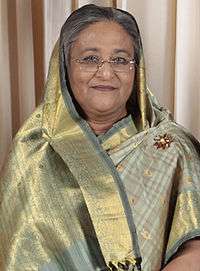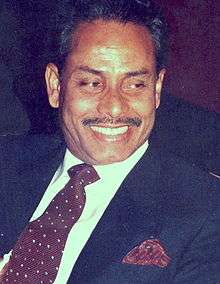Bangladeshi general election, February 1996
| | |||||||||||||||||||||||||||||||||||||||||||||||||||||||
| |||||||||||||||||||||||||||||||||||||||||||||||||||||||
| |||||||||||||||||||||||||||||||||||||||||||||||||||||||
| |||||||||||||||||||||||||||||||||||||||||||||||||||||||
 |
| This article is part of a series on the politics and government of Bangladesh |
|
Constitution |
|
Executive |
|
|
Political parties |
|
Foreign policy |
The Sixth National Parliamentary Elections 1996 (Bengali: ষষ্ঠ জাতীয় সংসদ নির্বাচন ১৯৯৬) was held in Bangladesh on 15 February 1996. They were boycotted by most opposition parties, and saw voter turnout drop to just 21%.[1] The result was a victory for the Bangladesh Nationalist Party (BNP), which won 300 of the 300 elected seats.[2] Fresh elections were held in June.
Background
In March 1994, controversy over a parliamentary by-election, which the Bangladesh Awami League-led opposition claimed the BNP government had rigged, led to an indefinite boycott of Parliament by the entire opposition. The opposition also began a program of repeated general strikes to press its demand that Khaleda Zia's government resign and a caretaker government supervise a general election. Efforts to mediate the dispute, under the auspices of the Commonwealth Secretariat, failed. After another attempt at a negotiated settlement failed narrowly in late December 1994, the opposition resigned en masse from Parliament. The opposition then continued a campaign of marches, demonstrations, and strikes in an effort to force the government to resign. The opposition, including the Awami League's Sheikh Hasina, pledged to boycott national elections scheduled for 15 February 1996.
In February, Prime Minister Khaleda Zia's BNP was re-elected for the second term after the sixth general elections by a landslide in voting boycotted and denounced as unfair by the three main opposition parties. In March 1996, following escalating political turmoil, the sitting Parliament enacted the thirteenth constitutional amendment to allow a neutral caretaker government to assume power conduct new parliamentary elections; former Chief Justice Muhammad Habibur Rahman was named Chief Advisor (a position equivalent to prime minister) in the interim government. New parliamentary elections were held in June 1996 and were won by the Awami League.
Bangladesh Awami League led grand alliance has arranged another election like this on 5 January 2014 amidst the protest of the main opposition BNP led 18 party alliance.[3] Only 11 of the 41 registered parties of Bangladesh are attending the election. Already 153 members of the 10th parliament has been declared winner uncontested which has produced huge debates.[4]
Results
| Party | Votes | % | Seats | +/– |
|---|---|---|---|---|
| Bangladesh Nationalist Party | 300 | +160 | ||
| Total | 11,776,481 | 100 | 300 | 0 |
| Source: Nohlen et al. | ||||
References
- ↑ Dieter Nohlen, Florian Grotz & Christof Hartmann (2001) Elections in Asia: A data handbook, Volume I, p525 ISBN 0-19-924958-X
- ↑ Nohlen et al., p537
- ↑ http://www.reuters.com/article/2013/11/25/us-bangladesh-election-idUSBRE9AO0PI20131125
- ↑ http://www.dhakatribune.com/politics/2014/jan/02/uncontested-polls-frustrate-first-time-voters


